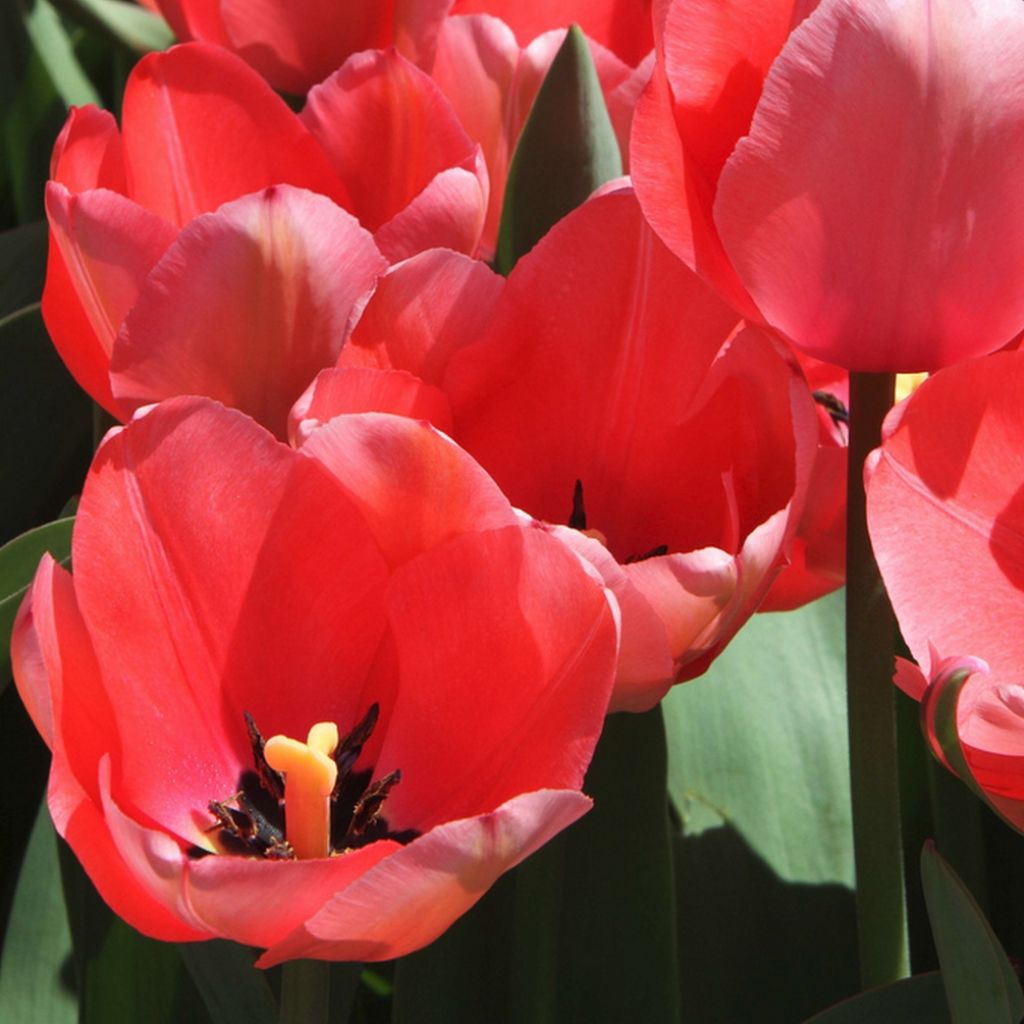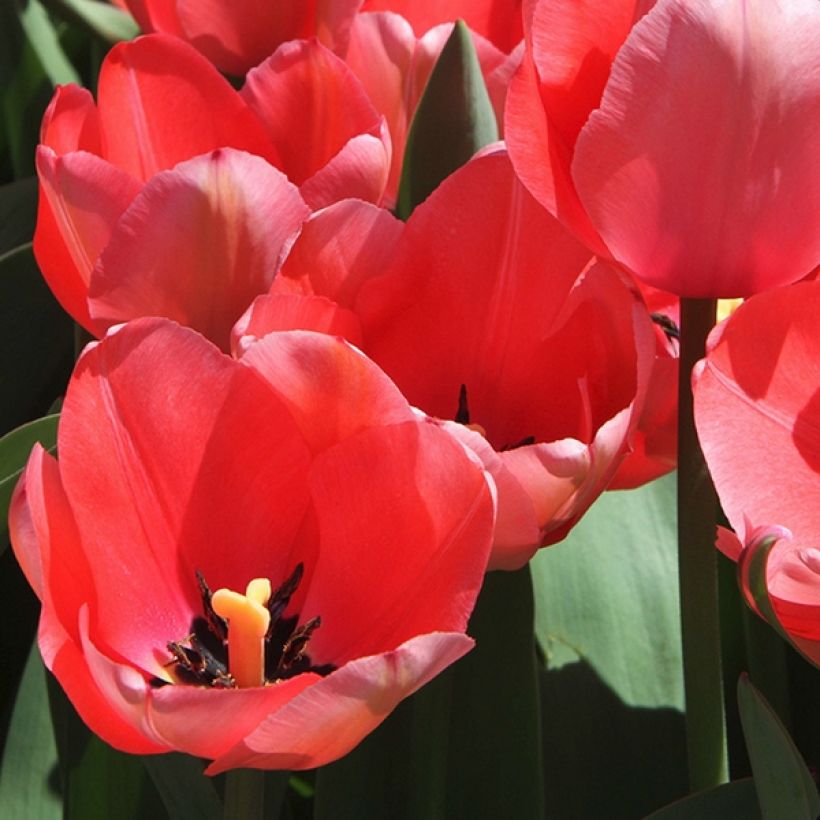

Tulipa praestans 'Unicum'
Tulipa praestans 'Unicum'
Tulipa praestans Unicum®
This plant carries a 6 months recovery warranty
More information
We guarantee the quality of our plants for a full growing cycle, and will replace at our expense any plant that fails to recover under normal climatic and planting conditions.
From €5.90 for pickup delivery and €6.90 for home delivery
Express home delivery from €8.90.
Does this plant fit my garden?
Set up your Plantfit profile →
Description
Tulipa praestans 'Unicum' offers a fabulous contrast and perfect colour coordination by raising its narrow, deep red corollas on beautiful variegated and marginated bright green foliage. It produces multiple flowers per stem, guaranteeing a generous spring flowering. Twice as ornamental, it is easy to cultivate and often naturalizes in most gardens, tirelessly blooming year after year in flower beds and planters.
As with all other tulips it belongs to the lily family. Tulipa praestans is a species native to Central Asia, where it grows at high altitudes on slopes and rocky scree, up to the clear undergrowth of the southern Pamir Alai. It has given rise to numerous cultivars, including T. praestans 'Unicum'. This medium-sized tulip will not exceed 35cm (14in) in height when in bloom. Its foliage is a vibrant green, fairly wide, strongly margined with white cream, showing some random variegation of the same shade. The flowers appear in April, gathered in groups of 2 to 4 at the top of the stems, more or less early depending on the climate. They are a bright deep red, and open widely to reveal a heart tinged with bright orange. They bloom in the sun and close when it hides. This tulip easily naturalizes through the production of bulblets, in light and well-drained soil.
Botanical tulips do not degenerate over time like large-flowered tulips. They naturalize and can remain in place for several years without any particular maintenance and thrive in borders and rockeries. To create colourful scenes, they can be associated with various small bulbous plants: Crocus, Muscari, Cyclamen coum, Snowdrops, Scillas... These tulips are unparalleled for bringing the colours of spring in pots or in sunny gardens.
Report an error about the product description
Tulipa praestans 'Unicum' in pictures


Plant habit
Flowering
Foliage
Botanical data
Tulipa
praestans
Unicum®
Liliaceae
Cultivar or hybrid
Planting and care
Plant Tulipa praestans 'Unicum' bulbs in autumn, from September to December, at a depth of 10cm (4in), spacing them 10cm (4in) apart. The planting should be done in ordinary soil, slightly acidic, neutral, or slightly alkaline, loose, well-worked, light, and well-draining. Botanical tulips appreciate dry soils in summer and cold winters. Never add undecomposed manure or compost to the planting soil, as this could cause the bulbs to rot. Tulips grow well in moist to dry soil. Plant them in a sunny or semi-shaded location.
After flowering, their foliage becomes unsightly. We recommend planting Heucheras, Tiarellas, Brunneras, Bleeding Hearts, Cyparissia Spurge, at the forefront of your flower beds. Their foliage will enhance the colours of your tulips, and during the season, they will elegantly conceal their yellowed leaves.
Planting period
Intended location
Care
This item has not been reviewed yet - be the first to leave a review about it.
Haven't found what you were looking for?
Hardiness is the lowest winter temperature a plant can endure without suffering serious damage or even dying. However, hardiness is affected by location (a sheltered area, such as a patio), protection (winter cover) and soil type (hardiness is improved by well-drained soil).

Photo Sharing Terms & Conditions
In order to encourage gardeners to interact and share their experiences, Promesse de fleurs offers various media enabling content to be uploaded onto its Site - in particular via the ‘Photo sharing’ module.
The User agrees to refrain from:
- Posting any content that is illegal, prejudicial, insulting, racist, inciteful to hatred, revisionist, contrary to public decency, that infringes on privacy or on the privacy rights of third parties, in particular the publicity rights of persons and goods, intellectual property rights, or the right to privacy.
- Submitting content on behalf of a third party;
- Impersonate the identity of a third party and/or publish any personal information about a third party;
In general, the User undertakes to refrain from any unethical behaviour.
All Content (in particular text, comments, files, images, photos, videos, creative works, etc.), which may be subject to property or intellectual property rights, image or other private rights, shall remain the property of the User, subject to the limited rights granted by the terms of the licence granted by Promesse de fleurs as stated below. Users are at liberty to publish or not to publish such Content on the Site, notably via the ‘Photo Sharing’ facility, and accept that this Content shall be made public and freely accessible, notably on the Internet.
Users further acknowledge, undertake to have ,and guarantee that they hold all necessary rights and permissions to publish such material on the Site, in particular with regard to the legislation in force pertaining to any privacy, property, intellectual property, image, or contractual rights, or rights of any other nature. By publishing such Content on the Site, Users acknowledge accepting full liability as publishers of the Content within the meaning of the law, and grant Promesse de fleurs, free of charge, an inclusive, worldwide licence for the said Content for the entire duration of its publication, including all reproduction, representation, up/downloading, displaying, performing, transmission, and storage rights.
Users also grant permission for their name to be linked to the Content and accept that this link may not always be made available.
By engaging in posting material, Users consent to their Content becoming automatically accessible on the Internet, in particular on other sites and/or blogs and/or web pages of the Promesse de fleurs site, including in particular social pages and the Promesse de fleurs catalogue.
Users may secure the removal of entrusted content free of charge by issuing a simple request via our contact form.
The flowering period indicated on our website applies to countries and regions located in USDA zone 8 (France, the United Kingdom, Ireland, the Netherlands, etc.)
It will vary according to where you live:
- In zones 9 to 10 (Italy, Spain, Greece, etc.), flowering will occur about 2 to 4 weeks earlier.
- In zones 6 to 7 (Germany, Poland, Slovenia, and lower mountainous regions), flowering will be delayed by 2 to 3 weeks.
- In zone 5 (Central Europe, Scandinavia), blooming will be delayed by 3 to 5 weeks.
In temperate climates, pruning of spring-flowering shrubs (forsythia, spireas, etc.) should be done just after flowering.
Pruning of summer-flowering shrubs (Indian Lilac, Perovskia, etc.) can be done in winter or spring.
In cold regions as well as with frost-sensitive plants, avoid pruning too early when severe frosts may still occur.
The planting period indicated on our website applies to countries and regions located in USDA zone 8 (France, United Kingdom, Ireland, Netherlands).
It will vary according to where you live:
- In Mediterranean zones (Marseille, Madrid, Milan, etc.), autumn and winter are the best planting periods.
- In continental zones (Strasbourg, Munich, Vienna, etc.), delay planting by 2 to 3 weeks in spring and bring it forward by 2 to 4 weeks in autumn.
- In mountainous regions (the Alps, Pyrenees, Carpathians, etc.), it is best to plant in late spring (May-June) or late summer (August-September).
The harvesting period indicated on our website applies to countries and regions in USDA zone 8 (France, England, Ireland, the Netherlands).
In colder areas (Scandinavia, Poland, Austria...) fruit and vegetable harvests are likely to be delayed by 3-4 weeks.
In warmer areas (Italy, Spain, Greece, etc.), harvesting will probably take place earlier, depending on weather conditions.
The sowing periods indicated on our website apply to countries and regions within USDA Zone 8 (France, UK, Ireland, Netherlands).
In colder areas (Scandinavia, Poland, Austria...), delay any outdoor sowing by 3-4 weeks, or sow under glass.
In warmer climes (Italy, Spain, Greece, etc.), bring outdoor sowing forward by a few weeks.


































